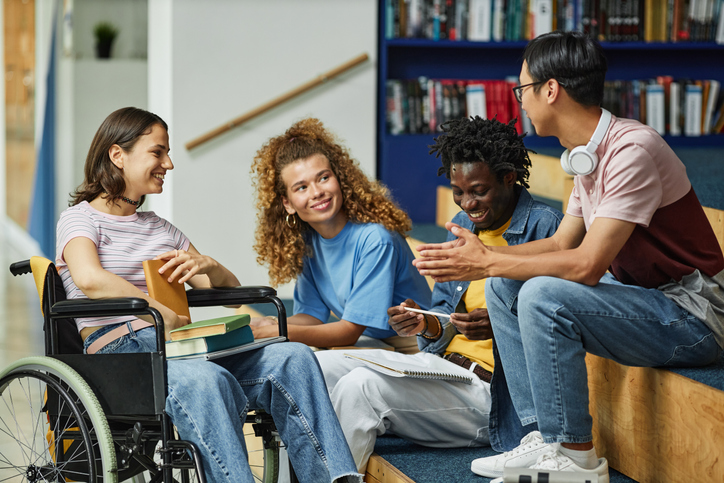The new drinking trend that’s all the rage across college campuses throughout the US is BORGs: short for “Black Out Rage Gallons,” a concoction of water, alcohol, flavoring, and electrolytes like Liquid I.V. or Pedialyte to “prevent against hangovers.” Poured into a jug and brandished with a humorous name (“Ruth Bader GinsBORG,” “BORG to be wild,” “Pablo EscoBORG,” and the like), these drinks are most often seen at parties—”day parties”—as students look for an easy way to sustain their buzzed or, as the name suggests, blackout state throughout the entire day.
These punchy drinks join the ranks of other aptly named substances; namely, “Study Buddies” or “Co-Pilots” (Adderall and other amphetamines); “Downers” (Xanax, Valium, and other benzodiazepines); and the less covert “Club Drugs” (ecstasy, ketamine, LSD, methamphetamines, bath salts, etc.)—all of which cover one of the four central motives driving substance use among students: socialization, academic performance, self-medication, and curiosity and boredom.
It is for these reasons that substance use on campus comes as no surprise to educators, researchers, campus leaders, and perhaps least of all, parents. Drinking and smoking culture have become synonymous with “campus culture;” a rite of passage that students come to understand as the heart of “the college experience.” All other explanations aside, these students are at a point in their development when their desire or impulse for sensation-seeking greatly surpasses their perception of risk, causing them to engage in more risky behaviors—experimentation with drugs and alcohol chief among them.
But while in the past many have preferred to write off students’ substance use as “a phase,” the numbers (and the experts who study them) contend that this is a real problem—especially now as dueling fentanyl and mental health crises exacerbate the risk of overdose and death among a reckless, short-sighted, and largely health-illiterate population. What’s more, while pursuing higher education, earning a degree, forming peer and professional networks, and exploring career opportunities have historically been considered protective factors against the development of substance use disorders, recent studies have found that nearly half of participating students met the criteria for at least one substance use disorder (SUD), indicating that such assumptions negate a wide swarth of students’ lived experiences.
Thus, as more institutions begin to sound the alarm about mental health and substance use issues on campus, adopting a proactive approach to prevent against substance misuse becomes invaluable. Doing so requires campus leaders to understand the (limited) data surrounding substance use trends among students, the various motives and risk factors that contribute to their propensity to use or abuse substances, and what resources students actually want and will engage with that will help to lessen their risk and improve their relationship with substances.
Student Substance Use by the Numbers: Where Things Are At
According to the latest reports, alcohol, cannabis, tobacco and nicotine products, prescription stimulants, benzodiazepines, cocaine, painkillers, and methamphetamines are—in that order—the most used substances across college and university campuses. A spring 2022 survey from the American College Health Association (ACHA) found that, in the three months prior to being polled, as many as:
- 93 percent of students had consumed alcohol
- 72 percent used cannabis
- 70 percent used tobacco or nicotine products
- 42 percent used prescription stimulants for non-medical purposes
- 36 percent used sedatives or sleeping pills for non-medical purposes
- 36 percent used cocaine
- 22 percent used painkillers for non-medical purposes
- 20 percent used methamphetamine
This data corroborates additional findings that the prevalence of annual alcohol consumption is highest among full-time college students between the ages of 18-24, as over half of students are reported to engage in heavy or binge drinking, while at least one in four report academic problems due to drinking; as well as claims that the rise of vapes and e-cigarettes—designed to help people quit smoking—has ironically created a vaping epidemic among a generation that was supposed to end smoking, in which nearly half of students who use tobacco or nicotine product admit to having an addiction.
Yet while this data comes from the responses of more than 54,000 undergraduates across the US, reports on such trends at individual institutions remains scant, reflecting the need for more research to be conducted among more niche cohorts in order to have a better grasp of a particular campus’ substance use trends, as well as a better understanding of what needs to be done to offset the risks and potential harms that come with them.
Why Students Use: A Cry for Help, for Attention, for Support, or a Remedy for Boredom?
Even so, while robust insights into the prevalence of substance use are rare, insights into students’ motivation for using, fortunately, are not.
There are a number of well-known factors that contribute to students’ substance use, ranging from those entirely out of their control, namely genetic predisposition and family history, to subtle, often overlooked influences, such as the presence (and importance) of Greek life and sports traditions, both of which are associated with increased use and consumption of drugs and alcohol, as well as the size of the campus and its proximity to nearby liquor stores and club scenes.
By far the most common risk factors and motives associated with students’ substance use, however, include:
- Stress, depression, anxiety, sleep disorders; “self-medication:” Arguably one of the most shared commonalities between all cases of substance abuse/misuse on campus is the motive to self-medicate. Decades worth of research have uncovered a clear correlation between adverse mental health conditions, such as depression, anxiety, and other mood disorders; schizophrenia, bipolar, and borderline personality disorder; post-traumatic stress disorder; sleep disorders; and suicidal ideation, and the likelihood of a co-morbid substance use disorder. This is especially the case for students with a lifetime, past, or current diagnosis of a mental health issue, who, for one reason or another (e.g., lack of health insurance, lack of finances, legal barriers, lack of health literacy) may either misuse their prescribed medications (I.e., taking them more often than is prescribed, taking a higher dosage than is prescribed) or use and/or misuse non-prescribed medications to treat their condition(s).
But more than that, the transition from high school to higher education, mirroring the transition from childhood into adulthood, has long since been considered a time of significant stress for students, as these burgeoning adults grapple with how to manage their academic, social, familial, professional, and personal responsibilities at the same time—and, for most of them, for the first time. For many students, the thrust into full independence is sudden, and with that, comes an inability or ignorance toward how to healthily meet their mental, emotional, physical, social needs. While on the one hand, students want to look at this newfound independence as a positive, “freedom” to do what they like, to have fun, to breathe easier, and to decide exactly how they wish to spend their time and energy without their family’s intervention, on the other hand, it can quickly become toxic as students struggle to find an anchor to tie themselves to on campus, a social network to keep them grounded and offer support in times of high stress or crisis, a mentor to guide them through uncharted territories, or a daily routine to stick to, whilst also struggling to hold themselves accountable to take care of their basic needs.
Compounded by the research that shows that the onset period for most mental health disorders is between the ages of 18 and 25 years old, this creates a rather adversarial environment for students in which psychological, psychosocial, and behavioral issues emerge in formally mentally healthy adolescents; a situation that is only exacerbated by the dual prevalence of mental health stigma and lack of previous mental health education that render students unlikely to seek help for their issues, or worse, unaware that they even have an issue at all, or at least one that is “worthy” of professional help—thus, their turning to and subsequent reliance on substances to cope.
According to the 2022 College Prescription Drug Study report released by The Ohio State University, of students who used prescription medications (e.g., painkillers and sedatives) for non-medical reasons in the past year, about:
- 40 percent of students claimed it was to “relieve pain”
- 35 percent claimed it was “to sleep”
- 41 percent said it was to “relieve anxiety”
- 25 percent claimed it was to “feel better”
- 20 percent cited “a personal or emotional problem” as their reason for using
As a collection of studies note, post-secondary students exhibit statistically lower levels of physical activity, substantially higher levels of sedentary behavior, poor dietary behaviors (including disparate rates of eating disorders) and sleeping problems—all of which can further aggravate students’ mental health and contribute to their misuse or dependence on substances.
- Pressure to perform; “academic enhancement:” Whether as a cause or consequence of students’ poor mental health—or, as a separate motive entirely, research consistently shows that academic pressures, i.e., the “need to succeed,” heavy courseloads, stressful tests or examinations, and poor grades, are all strongly associated with substance misuse. According to the ACHA’s survey, over 76 percent of students who reported misusing prescription stimulants cited studying or improving grades as their top reasons for doing so. Additionally, findings from The Ohio University study revealed that 70 percent of students are most likely to misuse prescription stimulants before an exam or during finals week. As their nickname, “study buddies,” suggest, students’ misuse of stimulants—namely Adderall—has surged in recent years, especially in the United States, as students’ trips to the library are often accompanied by worrisome amounts of caffeine in the forms of coffee or energy drinks as well as these so-called “buddies,” as students look for an easy solution to their exhaustion, boredom, or lack of concentration so that they can stay up late to study or get their work done on time.
- Social anxiety and peer pressure; “party trick:” Studies examining the correlation between “unstructured socialization” and substance use have consistently found that, when peers spend unsupervised and unstructured time with each other, they are more likely to engage in deviant behaviors, including substance misuse. This is especially true for post-secondary students, as they look for ways to entertain themselves and connect with their peers while left to their own devices for much of the day—whether that’s free time in between classes, time spent in their residence halls, nights, and weekends. But not only is their lack of social control to blame for this inclination toward deviance, but also their susceptibility to peer influence.
As is often echoed by parents, experts, educators, campus leaders, and throughout pop culture, college or university is where you go to find your “forever friends:” “the friends you make in college are friends you’ll have for life,” is just one popular quote that often makes the rounds. Implicit within such statements, however, is the reality that, for many students, arriving to campus marks the beginning of a new start or a clean slate in which students must rebuild their social networks and resource base from the ground up. This sudden lack of quality friendships, coupled with statements that place such a heavy emphasis on the friendships formed on campus, put an immense pressure on students to quickly make new friends. As such, students become more sensitive about how they are perceived by others, care more deeply about being liked by their peers, grow less confident and comfortable with themselves, and subsequently become more likely to imitate behaviors exhibited by peers they wish to impress—like the use of substances.
In fact, many studies examining the social contagion effect of substance use on campus have found that students with close friends or classmates who use substances are more likely to use the same substances themselves compared to students who are not vicariously exposed to substance use—with statistical significance. Beyond mere peer pressure, however, is also the notion that using substances can alleviate social anxiety and thus act as enhancements for socializing. For instance, findings from The Ohio State University study confirmed that nearly a quarter of students who use stimulants for non-medical purposes do so to “enhance social interactions.”
- Easy, often ubiquitous, access; “connections:” Even for students who perhaps might bear some resilience against peer pressure or who might otherwise feel comfortable in themselves and in their relationships with others, the amount of exposure to substances that students get on campus is enough to increase their likelihood of engaging, research shows. The rise of e-cigarettes across campuses, for instance, is in large part linked to their accessibility, as they are both easy to legally obtain or to cop off of a friend. Students at larger schools—that is, those with at least 15,000 students—are also more likely to use substances than those at smaller schools, a 2022 study While factors like larger sports traditions, Greek life, and proximity to city life are all likely causes, it makes sense that a larger number of students would correlate with a larger number of substance users because of the increased access to connections or plugs (aka dealers). The rise of apps like Snapchat and Venmo have only made such transactions easier—and harder to catch, experts warn, as students can spot potential dealers through certain emojis they use in their usernames, and text in emojis to organize transactions without having to say anything incriminating.
- Demographic factors; discrimination, harassment, and isolation: Research into rates of substance abuse among various groups contend that marginalized communities, e.g., BIPOC, LGBTQ+ communities, are more likely to misuse substances compared to their white, cisgender, and heterosexual counterparts—largely on account of the discrimination and victimization that they face. According to one study, exposure to discrimination was associated with an excess of 44 cases of marijuana use per 1000 students, and an excess of 39 cases of alcohol use per 1000 students. Students who had experienced discrimination were also found to be more than twice as likely to use virtually every class of substance compared to their peers, from alcohol, cigarettes, and marijuana, to methamphetamine, cocaine, and opiates.
- Family history, characteristics: Decades’ worth of research on addiction has continuously found that an individual’s propensity for addiction or substance use disorders is heavily influenced by genetic traits and family histories of substance abuse. In fact, some experts maintain that genetic risk factors account for nearly half of a person’s likelihood of developing an addiction. Furthermore, early exposure to use of substances, childhood exposure to trauma related to substance use, lack of family involvement or support, and familial beliefs or attitudes that condone and/or promote the misuse of substances are all associated with an increased risk of substance misuse among students.
- Sheer boredom; “experimenting:” Seeing how college is oft touted as a time for self-exploration, experimentation, and trying new things, it doesn’t come as a surprise that, for many students, this logic extends to substances. “You can’t be an alcoholic until you graduate,” is just one example of the many erroneous mantras that students live by on campus, in which thrill or sensation-seeking, “having fun,” and “playing around” trump being safe or cautious. It’s the reason why the use of psychedelics or hallucinogens has gained popularity in recent years, as findings from the OSU survey show that the desires to “escape reality,” or see what certain drugs “feel like,” are one of the leading motives driving non-medical use of substances on campus. Even past research has consistently shown that curiosity alone is enough to cause students to fall into a substance use issue.
As Patrick O’Keefe, a licensed substance abuse counselor, shared in an article for The Auburn Plainsman, “From my experience, addiction develops from seeking immediate gratification to compensate for ‘something’ missing. That ‘something’ can range from boredom to overcoming stress and other negative emotions.'” As students look for ways to fill their unstructured days, turning to substances might seem like an easy way to pass the time and liven up the tedium of campus life.
What Institutions Can Do
With all these various risk factors and possible motives in mind, eliminating the use of substances on campus sounds impossible…and that’s because it is. In fact, studies have shown that interventions focused on abstinence or other zero-tolerance approaches have little to no impact on curbing students’ substance use.
Rather than striving for such a lofty goal, institutions must instead focus on more realistic aims: namely, working with students to perhaps reduce the prevalence of substance use on campus, but more importantly, to reduce the adverse consequences associated with misuse.
As these risk factors indicate, students are dealing with stressors in virtually every facet of their life; to tackle just one or two of these stressors would be futile. Thus, while traditional counseling and crisis support are both necessary interventions for supporting students struggling with substance misuse, it’s important that institutions look beyond mental health support and move toward a more holistic approach.
The transition from high school to higher ed is all-encompassing: In addition to the independence that they’re granted within their academic and daily schedules, they’re also, for the most part, expected to become financially independent; they’re expected to take a more active role in their academics, but also in their working life and professional development, in effect making their own life decisions. They’re expected to form their own social networks separate from what they had established through their families or communities back home. They’re expected to take care of their own needs—physical, nutritional, emotional. And perhaps most dauntingly, they’re left to determine what gives them meaning, purpose, and fulfillment in life…questioning their beliefs, their values, their dreams, and their ambitions.
All of that to say: they’re in desperate need of support to help them balance each of these new responsibilities. The problem is, far too many students currently feel “untethered” or detached: Despite gains in independence, many have lost their former sense of self, their worldview, their identity: they’re questioning who they are and who they want to be, without the presence of their family, childhood friends, or a robust social network to guide them. As a result, many students fall into pits of doubt and despair, feeling stuck, helpless, lost, and afraid, resulting, of course, in substance misuse. But by implementing a holistic wellbeing program that promotes both individual and collective empowerment, campus leaders can reduce students’ reliance on substances by showing them that they do possess the skills—or better yet, strengths—to manage stress in healthy and conducive ways, that they can grow out of their current situations and rise to the occasion, and that they are not alone, and furthermore, that they do not have to go through these stressful transitions alone.
So what does that ultimately entail?
As the World Health Organization defines health as “a state of complete physical, mental, and social wellbeing,” the term holistic wellbeing ultimately refers to a state of wellness within all dimensions of health: physical, mental, emotional, social, and spiritual. Thus, an efficacious holistic wellbeing program is a series of interventions that aim to simultaneously address individuals’—in this case, students’—various health needs. This includes addressing multiple health behaviors at the same time, rather than targeting just one or two (e.g., using counseling to improve students’ mindfulness)—which evidence has shown is often more effective at eliciting positive health behavior changes compared to more siloed approaches.
At the University of North Carolina Greensboro, for example, the school’s Quality Enhancement Plan (QEP) is designed to promote healthy lifestyles among students, helping them to differentiate between the different dimensions of wellbeing (of which the QEP proposes there are eight) and identify potential strategies to enhance each dimension, including:
- Adhering to important health guidelines such as getting enough sleep, consuming a healthy, balanced diet, and exercising regularly to maintain physical wellness.
- Developing collaborative and mutually beneficial relationships in conjunction with effective communication and self-regulation skills to maintain social wellness.
- Exploring, identifying, and understanding the role that one plays or wants to play within their larger community and or the world at large to maintain environmental and vocational wellness.
- Demonstrating strong money management skills to maintain financial wellness.
- Learning to seek and appreciate multiple perspectives on life’s challenges, embrace differences, and recognize the value that a diverse community has to offer to maintain cultural wellness.
Following this framework, an effectual holistic wellbeing program can best be understood as one in which (i) psychoeducation and awareness, (ii) cognitive-behavioral changes (iii) peer support and social-emotional learning, and (iv) campus engagement and community-building are prioritized and leveraged to foster students’ resilience against the various stressors associated with substance misuse.
Psychoeducation and Awareness
At the core of any effective health and wellness initiative is the aim to enhance individuals’ growth and development through the teaching of new concepts, competencies, and techniques; the aim to raise individuals’ awareness of their own health and wellness needs, their personal triggers or stressors, and the resources (both internal and external) they have at their disposal to meet their needs and cope with stress.
Within the context of higher education, this entails:
- Teaching students the fundamentals of health and wellbeing, including how to identify stressors and early signs and symptoms of stress and ill-health, and the importance of exercise, sleep, nutrition, positive relationships, healthy coping mechanisms, mindfulness, the mind-body connection, and emotional regulation
- Enhancing students‘ knowledge and challenging their current attitudes, beliefs, and behaviors related to substances with the intention of enabling them to make informed decisions about substance use by raising awareness of risks and consequences associated with substance misuse, as well as the risk factors that may make substance use riskier for certain individuals
- Normalizing students‘ experiences with stress, depression, anxiety, loneliness, uncertainty, etc., and helping to break the stigma surrounding talking about one’s mental or emotional health and or seeking help to deal with personal issues.
- Identifying resources that students’ have access to both on and off campus, providing clear guidelines on how they can go about accessing support, and offering tips and techniques on how students can self-monitor their health and wellbeing and self-regulate and relieve stress on their own
- Helping students to set realistic goals and expectations, make plans for achieving them, practice self-compassion in the face of setbacks or mistakes, and practice self-acceptance in order to maintain wellbeing
As countless studies affirm, the sooner that adolescents learn to deal with their stress, the healthier they will be in all aspects of their life as burgeoning adults. By differentiating between helpful and harmful coping strategies, spotlighting available resources, and boosting students’—especially first-year students’—self-awareness, self-mastery, and self-efficacy, institutions can aspire to steer students away from the false sense of relief that substances are thought to provide.
Cognitive-Behavioral Changes
Accompanying psychoeducation and awareness campaigns should inevitably come coaching, counseling, and behavioral and emotional skills training. This is where campus leaders should aim to collaborate with accredited health, wellness, and lifestyle coaches, mental health counselors, and other trained professionals to organize interventions aimed at enabling students to modify their behaviors, improve their outlook or attitudes toward life, identify strengths, skills, resources, and how they can take advantage of them, and ultimately, take care of their needs and accomplish their goals.
This includes, but is not limited to, teaching students how to:
- Improve their physical activity and sustain a moderately active lifestyle
- Maintain a healthy diet
- Identify and regulate their emotions through mindfulness exercises, meditation, and journaling
- Say no and set healthy boundaries
- Be compassionate to oneself; to accept and embrace failures or mistakes
Numerous studies have demonstrated the benefits that health coaching in particular can offer to students, especially when it comes to reducing risky behaviors. By having access to a guide that will hold them accountable for their actions, teach them how to hold their own selves accountable, and how to self-monitor for signs of distress and promptly take the right steps to protect one’s health, students can learn how to imagine more positive and sustainable solutions to their problems, how to establish and strive after realistic goals, and how to keep moving forward in the face of challenges.
Peer Support and Social-Emotional Learning
In tandem with targeted, individual-level interventions aimed at improving students’ health behaviors, it is also crucial that institutions foster positive peer relationships and leverage peer support to enhance students’ stress resilience and emotional regulation, cultivate a sense of belongingness, and create health-positive social norms.
As quite a few of the outlined risk factors elucidate, peer relations play a strong, if not leading, role in determining students’ self-esteem and self-confidence. As such, positive peer relationships are a proven protective factor against drunk driving, sensation-seeking, and substance use, as research shows that students with strong social connections are better at coping with stress, demonstrate greater self-efficacy, and feel a greater sense of accomplishment for overcoming challenges. This is largely because peer relationships are essential to students’ social-emotional development, in which interacting with others enables them to develop their skills when it comes to self-control, self-management, and self-awareness while also instilling them with greater social awareness to make responsible, prosocial decisions.
This is especially the case for post-secondary students, who, in their unique and vulnerable position, are much more susceptible to peer pressure and the influence of role models. It is for that reason that many experts underscore the importance of group-wide interventions when it comes to mitigating the prevalence of substance misuse on campus, as engagement in peer support groups allows students to validate their own experiences, consider multiple perspectives from which to assess their own challenges, and learn how to proactively and positively take care of their own needs by listening to and collaborating with others whom they can relate to on a much deeper level compared to professionals.
Institutions can cultivate peer support through a variety of modalities, including but not limited to:
- Support groups and group counseling (online and in-person)
- Student-led clubs and organizations
- Peer mentorship or advocacy programs
- Various wellness activities that foster peer partnerships, including:
- Arts therapy (music, theatre)
- Guided yoga or meditation
- Walking or hiking activities
- Dance, fitness, or cooking classes
When students have friends to lean on for support, to rely on for entertainment, to observe as positive models, and to motivate oneself to continuously grow and learn in pursuit of one’s ambitions, they are all the more equipped to effectively deal with any obstacles that come their way and avoid many of the adverse conditions associated with substance misuse, namely, depression, anxiety, isolation, poor academic performance, and boredom.
Campus Engagement and Community-Building
In addition to leveraging peer support, experts unanimously emphasize the importance of creating a safe, supportive, and united campus to protect against social deviancy, isolation and or victimization, and feelings of helplessness or hopelessness. One of the many dual causes and consequences of substance misuse, particularly among younger adults like students, is social isolation: feelings of loneliness, fear of judgment and rejection, feeling unheard, unseen, or perhaps misunderstood. This causes students to turn to substances to cope, rather than turning to their peers or anyone on campus, for that matter, for support; and as a consequence for the shame, guilt, and loneliness that they may feel as a result of their substance use, neither do they turn to anyone for support with their substance use issues, either.
But by fostering a benevolent, welcoming, and good-natured campus environment in which all students are cognizant of the signs and risks associated with poor mental health and substance misuse, are empathetic to their peers’ social-emotional or psychosocial needs, and feel a sense of kinship or closeness with each of their peers, campus leaders can creative a conducive environment for students hoping to recover from substance use issues and for students who may be susceptible to substance misuse, as recovering students can comfortably reassimilate into campus life without having to fear being judged or rejected, while vulnerable students can find healthier outlets to deal with any issues they may be struggling with whether on or off campus.
Not only that, but campus engagement can also help to instill students with a sense of meaning and purpose that permeates most of the common risk factors associated with substance misuse (think: boredom and depression). In fact, one study found that for students who participated in volunteer activities on campus, there was a 5 percent reduction in binge-drinking behavior; at the campus-level, such volunteerism resulted in a marked 26 percent decrease in such behaviors. By offering students a prosocial, altruistic, and meaningful outlet to express themselves and, more importantly, explore who it is they are and who they want to be, campus leaders can effectively build up students’ strength, their self-confidence, self-efficacy, and resilience against substance misuse.



































